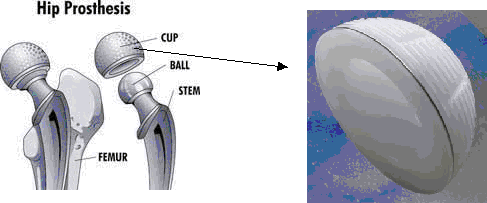Professor James Economy's Group
|
|
[Polymer Blends] [Microelectronic Polymers]
[Liquid Crystalline
Polyesters] [Polyester Thermosetting Resins] UHMWPE/ATSP
Blends Due to
its high impact resistant, low wear rate, low friction,
biocompatible in large pieces and sterilizable, ultrahigh
molecular weight polyethylene (UHMWPE) has been
successfully used as joint replace materials, such as
socket - acetabular cup (see Figure 2). Today nearly
250,000 total hip replacements are done in the U.S.
yearly. Approximately 10% of total hip replacements will
fail in the first ten years, and another 30 to 40% over
the next ten years. Gross wear can cause loosening
directly, but wear particles can cause inflammation and
bone erosion and thus indirectly cause loosening. It was
not until the early 1990s that the production of UHMWPE
debris at the articulating surface of joint replacements
was widely recognized to play a central role in
initiating osteolysis. Since that time, orthopedic
research efforts have focused increasingly on improving
UHMWPE, with the goals of reducing wear and, by
implication, improving implant survival, especially for
young active patients. Currently, improving UHMWPE is
focusing on forming cross-linking structure by radiation.
To provide a more stable structure and lower wear loss
surface, UHMWPE and ATSP (aromatic thermosetting
polyester ) blends were developed in our group. In the
primary Dynamometer wear test, the blend system with
small amount compatibilizer showed lower wear rate
compared to UHMWPE. Further wear test is underway to
confirm this result followed by the cell-culture
experiment to identify its biocompatibility.
Figure.
UHMWPE acetabular cup. Aromatic
Thermosetting Polyester (ATSP) / Polytetrafluoroethylene
(PTFE) Composites Polytetrafluoroethylene,
PTFE (trade name Teflon®), has superb lubricity and has
been widely used in tribological applications. Its
mechanical properties, however, are low compared to other
thermoplastic polymers, among which the wear rate and
defomability are especially poor. PTFE is intractable, it
can not be melt processed. It must be either sintered or
extruded in a paste-like suspension under very high
temperature (~400°C) and pressures (free sintering above
3000psi). A novel
type of PTFE composites have been developed, taking
advantage of the unique characteristics of the aromatic
thermosetting polyester, including solid state bonding
and high temperature properties. The solid state bonding
capability due to Interchain Transesterification
Reactions (ITR), allows free blending and sintering with
PTFE at the temperatures and times which PTFE is
typically processed. To
enhance mixing and improve the interface adhesion, fine
powders of ATSP were prepared by solution polymerization
of trimesic acid, hydroquinone diacetate, isophthalic
acid and acetoxybenzoic acid. It was found thermosetting
polyester could indeed stiffen and strenghthen pure PTFE,
besides, ATSP powders ( 20µm in diameter) improved the
flow property of PFPE, hence, a broad processing window
of 100°C was found , and ATSP/PFPE, ATSP/PFPE/Zonyl
fluoropolymer composites were fabricated with excellent
mechanical properties. |
||||||||||||||||||||||||||||||||||||||||||||||||||||||

